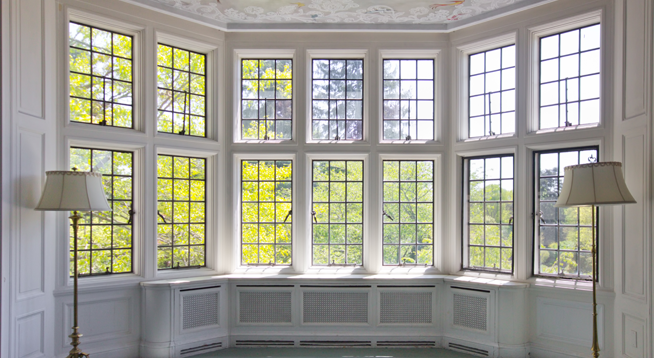Inside Outside Guys: Understanding Window Ratings
By Ken Calverley and Chuck Breidenstein
DETROIT, October 14, 2021 ~ How would you like to have the “windows” from 13th-century Rome in your home these last few rain-drenched months?
They were simply a hole built into the roof to allow for natural light and ventilation.
Just 200 years ago, many homes minimized their windows and used everything from flattened animal horn to cloth, grease-paper and wood to close off the opening in bad weather.
As recently as the mid 70s, single-pane windows with aluminum frames were the “stock” item in supplier’s warehouses and only the upper-priced homes got double-pane glass and wood frames.
Indeed, windows have come a long way in a relatively short period of time.
Data shows that up to 70% of the energy loss in a home is through windows and doors, with 90% of that through the glass.
Up until the 1970s we were not culturally concerned about energy efficiency, much less energy savings, so who cared if heat loss was so great that frost built up around the windowsills during cold weather spells?
This was such a common occurrence and contributing cause to rotted windowsills that we used to “upgrade” buyers to synthetic “marble” sills knowing we wouldn’t have to replace them five years down the road due to dry rot.
Once the country experienced a couple oil embargoes that caused our home energy bills to skyrocket, we became more conscious of the need for better product.
In the early 90s, national energy codes began to mandate minimum energy performance for various housing products, and it was out of that requirement that testing standards evolved to allow us to compare various fenestration (window and door) products.
Groups such as the National Fenestration Rating Council, NFRC, became the “go to” resource for window and door manufacturer’s seeking a competitive edge with energy efficient product. At the national level, the Energy Star program evolved to create minimum energy performance standards for various products from computer monitors to windows.
Today, you can simply go online to either of these groups to verify the energy efficiency of a window or door you are looking to specify.
While this was going on, certain groups were trying to limit how much glazing, read windows, could be incorporated into a home. Under their proposals, you would never have a room with windows on all three walls. Luckily the Home Builder’s Association and other groups have successfully fended off these “no-window” advocates.
The compromise has been to require minimum energy performance testing and rating for any fenestration product used in new or replacement construction.
If you look at a new window, you will see a label on the glass indicating U value, a Solar Heat Gain Coefficient, SHGC, a Visible Transmittance, VT, rating and an Air Leakage, AL, rating. These are the minimum requirements for new product. Some units may also have a Condensation Rating indicating the unit’s resistance to getting condensate on the glass.
Most of us recognize R Value in thermal insulation materials as representing a materials’ resistance to heat transfer. Higher R value equals better insulator. U value is used to indicate how much heat flow occurs through a material or set of materials due to the difference between indoor and outdoor temperatures. So lower U value equals better energy performance. It is represented as a fraction of 1.
The 2018 International Energy Conservation Code, IECC, requirement for windows in this part of the country is U=.30, equal to an R 3.333. Under the 2015 edition of that code, it was U=.32. There is product on the market today that claims a U value of .05, which is the equivalent of an R 17!
SHGC is a rating of how much of the suns solar radiation penetrates the unit. It is also expressed as a fraction of 1, so we want a lower number like .32 for this. This can help keep summer spaces cool and minimize damage to furnishings and people from UV rays.
VT is an indication of how much actual light the window will allow. Once again, it is expressed as a fraction of 1, so higher is better for many homes seeking lots of light from those windows.
AL is used to indicate how much air actually moves through the unit. Expressed as a fraction of 1, you want a lower comparative rating.
There are also films to consider when rating efficiency. You may have heard of low E films that reflect harmful rays from the sun and can also reflect heat back into a home’s space in the winter. Some manufacturers will use several such films to improve window performance.
In most of those multi-pane windows, there is either air or a vacuum between the pieces of glass. But we found if we fill that space with Argon or Krypton, we can slow heat transmission even further.
At the end of the day, the best window installed poorly will not perform well. Great installation technique and practice combined with solid written warranty can help you make a difficult and, hopefully, once-in-a-lifetime decision on the best next window for your home.

